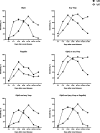Development and Validation of a Protein Array for Detection of Antibodies against the Tick-Borne Pathogen Borrelia miyamotoi
- PMID: 36314925
- PMCID: PMC9769530
- DOI: 10.1128/spectrum.02036-22
Development and Validation of a Protein Array for Detection of Antibodies against the Tick-Borne Pathogen Borrelia miyamotoi
Abstract
Current serological tests for the emerging tick-borne pathogen Borrelia miyamotoi lack diagnostic accuracy. To improve serodiagnosis, we investigated a protein array simultaneously screening for IgM and IgG reactivity against multiple recombinant B. miyamotoi antigens. The array included six B. miyamotoi antigens: glycerophosphodiester phosphodiesterase (GlpQ), multiple variable major proteins (Vmps), and flagellin. Sera included samples from cases of PCR-proven Borrelia miyamotoi disease (BMD), multiple potentially cross-reactive control groups (including patients with culture-proven Lyme borreliosis, confirmed Epstein-Barr virus, cytomegalovirus, or other spirochetal infections), and several healthy control groups from regions where Ixodes is endemic and regions where it is nonendemic. Based on receiver operating characteristic (ROC) analyses, the cutoff for reactivity per antigen was set at 5 μg/mL for IgM and IgG. The individual antigens demonstrated high sensitivity but relatively low specificity for both IgM and IgG. The best-performing single antigen (GlpQ) showed a sensitivity of 88.0% (95% confidence interval [CI], 78.9 to 93.5) and a specificity of 94.2% (95% CI, 92.7 to 95.6) for IgM/IgG. Applying the previous published diagnostic algorithm-defining seroreactivity as reactivity against GlpQ and any Vmp-revealed a significantly higher specificity of 98.5% (95% CI, 97.6 to 99.2) but a significantly lower sensitivity of 79.5% (95% CI, 69.3 to 87.0) for IgM/IgG compared to GlpQ alone. Therefore, we propose to define seroreactivity as reactivity against GlpQ and any Vmp or flagellin which resulted in a comparable sensitivity of 84.3% (95% CI, 74.7 to 90.8) and a significantly higher specificity of 97.9% (95% CI, 96.9 to 98.7) for IgM/IgG compared to GlpQ alone. In conclusion, we have developed and validated a novel serological tool to diagnose BMD that could be implemented in clinical practice and epidemiological studies. IMPORTANCE This paper describes the protein array as a novel serological test for the diagnosis of Borrelia miyamotoi disease (BMD), by reporting the methodology, the development of a diagnostic algorithm, and its extensive validation. With rising numbers of ticks and tick bites, tick-borne diseases, such as BMD, urgently deserve further societal and medical attention. B. miyamotoi is prevalent in Ixodes ticks across the northern hemisphere. Humans are exposed to, and infected by, B. miyamotoi and develop BMD in Asia, in North America, and to a lesser extent in Europe. However, the burden of infection and disease remains largely unknown, due to the noncharacteristic clinical presentation, together with the lack of awareness and availability of diagnostic tools. With this paper, we offer a novel diagnostic tool which will assist in assessing the burden of disease and could be implemented in clinical care.
Keywords: Borrelia miyamotoi; Borrelia miyamotoi disease; hard-tick-borne relapsing fever; relapsing fever Borrelia; serology.
Conflict of interest statement
The authors declare no conflict of interest.
Figures


References
-
- Fukunaga M, Takahashi Y, Tsuruta Y, Matsushita O, Ralph D, McClelland M, Nakao M. 1995. Genetic and phenotypic analysis of Borrelia miyamotoi sp. nov., isolated from the ixodid tick Ixodes persulcatus, the vector for Lyme disease in Japan. Int J Syst Bacteriol 45:804–810. doi:10.1099/00207713-45-4-804. - DOI - PubMed
Publication types
MeSH terms
Substances
Supplementary concepts
LinkOut - more resources
Full Text Sources

